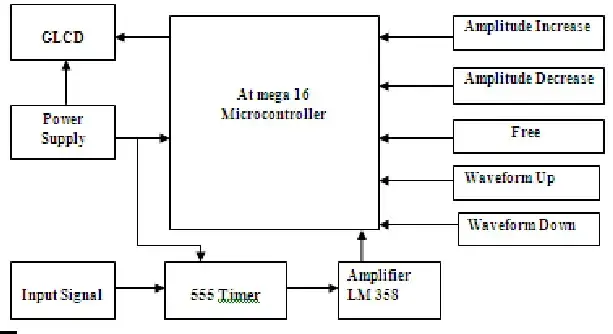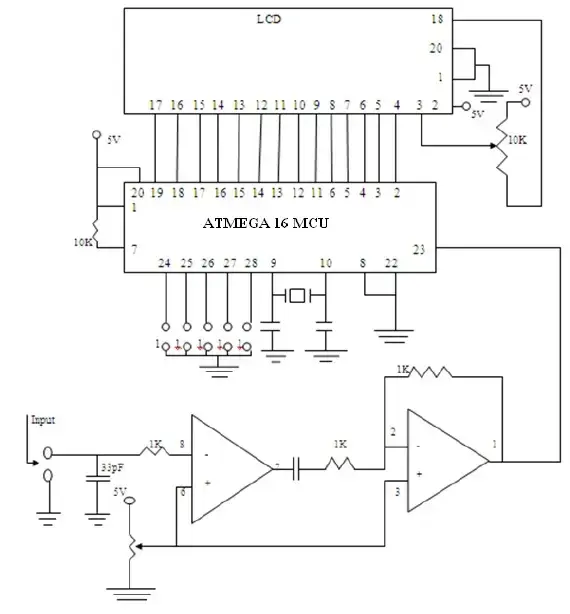Summary of Graphical LCD Oscilloscope using ATmega16Microcontroller
This project designs a portable oscilloscope using the ATmega16 microcontroller and a JHD12864E graphical LCD to display analog signal waveforms. It samples input signals through a built-in 10-bit ADC, converts them to 6-bit data for the 128x64 display, and visualizes waveforms like square waves up to 200 Hz. The system is controlled via toggle switches for settings and aims to offer a compact, cost-effective alternative to bulky CROs, supporting educational and embedded applications with optimized sampling and display performance.
Parts used in the Portable Oscilloscope Project:
- ATmega16 Microcontroller
- JHD12864E Graphical LCD (128x64 pixels)
- Analog-to-Digital Converter (built-in 10-bit ADC in ATmega16)
- 555 Timer (for clock generation)
- Toggle switches (five units for user settings)
- Power supply (5V)
- Oscilloscope probe
Introduction
The popularity of microcontrollers is on the rise, thanks to their compact size and impressive capabilities. Embedded systems are being constructed around microcontrollers and peripheral devices [3]. An oscilloscope is frequently employed to observe the waveform of an electrical analog signal, typically representing voltage, time, and frequency. Parameters such as peak-to-peak voltage, frequency of a periodic signal, and the time it takes for a signal to reach full amplitude are measured. While conventional cathode-ray oscilloscopes (CRO) are commonly used for such tasks, they are bulky and inconvenient to transport. The objective of this project is to design a portable oscilloscope.
Working Principle
The operation of a Graphical LCD is based on the fundamental concept of the sampling theorem. According to this theorem, the sampling frequency must be at least twice the highest frequency component present in the signal, as indicated by equation (1):
\[ f_s \geq 2f_c \]
Here, \( f_s \) represents the sampling frequency, and \( f_c \) is the highest frequency component in the signal. To facilitate the sampling process, an Analog-to-Digital Converter (ADC) is employed, with a conversion time of 30 microseconds [5]. It is crucial to utilize this time effectively for displaying data on the Graphical LCD. Failure to do so may lead to an increase in the time difference between three consecutive samples, subsequently reducing the system’s sampling rate [8]. Consequently, the overall frequency range of the system will decrease.
For optimal performance, it is advised to ensure that the maximum frequency of an external clock source is less than the clock frequency, and the clock frequency falls within the range of 50 KHz to 200 KHz. This range ensures maximum resolution, and the conversion time of the ADC is specified to be between 13µs and 260µs.
ATmega16 Microcontroller
Graphical LCD
We developed a graphical LCD driver specifically tailored for the crystal fonts 12864B 128×64 pixel graphical LCD. In Figure 1, the block diagram of the ATMEGA16 microcontroller, along with the entire system, is depicted[3]. The graphical LCD and 555 timer receive power supply. Additionally, five toggle switches are employed for various settings as specified.

Description of new system
The process unfolds in the following sequence:
1. Commencing with the acquisition of an analog input signal from the device.
2. Subsequently, initializing the graphical LCD.
3. Converting the analog signal into a digital signal through the built-in ADC in the ATmega16 microcontroller.
4. Implementing alterations based on user specifications.
5. Ultimately, presenting the result on the graphical LCD.

Description of Circuit diagram

To display data on these points, only 6 bits are necessary. However, as mentioned earlier, the ADC possesses a 10-bit resolution[5]. Representing 10-bit data requires 1024 points, but our display column accommodates only 64 points. To address this limitation, it is necessary to convert the 10-bit digital ADC value into 6 bits. This conversion can be achieved in two ways: i) Discarding the first four bits from the MSB of the 6-bit data, which reduces the range while preserving the resolution. ii) Discarding the first four bits from the LSB of the 6-bit data, which also reduces the range while maintaining resolution.
Programming Details
Result and Discussion

Conclusion
This embedded system enables the analysis of low-frequency signals and voltage amplitudes. It aids students in creating a new, compact-sized system with significantly lower costs compared to existing portable oscilloscopes.
